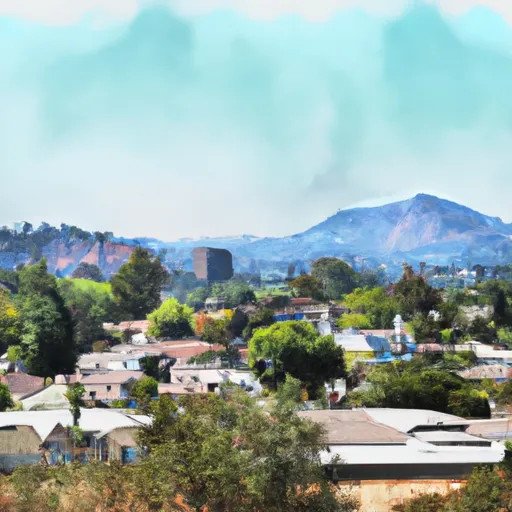-
 Snoflo Premium
Snoflo Premium
Get unlimited access to all our content
With no Ad interruptions! - Start Your Free Trial Login with existing account
Tujunga
Eden Index
Climate
9.6
•
Recreation
7.6
•
Community
4.6
•
Safeguard
7.7/10

Tujunga is a neighborhood located in the northeastern part of Los Angeles, California. It is situated in the San Gabriel Valley, which is known for its diverse climate and breathtaking landscapes. Tujunga experiences a Mediterranean climate, characterized by hot, dry summers and mild, wet winters. Summers can be scorching with temperatures often reaching over 90°F (32°C), while winters are mild with temperatures averaging around 65°F (18°C).
Hydrologically, Tujunga is surrounded by the majestic San Gabriel Mountains, which provide a stunning backdrop and contribute to the neighborhood's unique water resources. The area is known for its two major watercourses, the Big Tujunga Wash and the Little Tujunga Creek, which flow through the region and sustain several species of plants and wildlife.
Outdoor enthusiasts will find a range of recreational opportunities in Tujunga. The nearby Angeles National Forest offers hiking trails, camping sites, and scenic picnic spots. The mountains provide opportunities for rock climbing, horseback riding, and mountain biking. Additionally, the Hansen Dam Recreation Area, located just south of Tujunga, offers a variety of water-based activities, including boating, fishing, and swimming. With its diverse climate, beautiful landscapes, and numerous recreational opportunities, Tujunga is a haven for nature lovers and outdoor enthusiasts.
What is the Eden Index?
The Snoflo Eden Index serves as a comprehensive rating system for regions, evaluating their desirability through a holistic assessment of climate health, outdoor recreation opportunities, and natural disaster risk, acknowledging the profound impact of these factors on livability and well-being.
Climate Health Indicator (CHI): 9.6
Tujunga receives approximately
609mm of rain per year,
with humidity levels near 72%
and air temperatures averaging around
17°C.
Tujunga has a plant hardyness factor of
10, meaning
plants and agriculture in this region tend to thrive here all year round.
By considering the ideal temperature range, reliable water supplies, clean air, and stable seasonal rain or snowpacks, the Climate Health Indicator (CHI) underscores the significance of a healthy climate as the foundation for quality living.
A healthy climate is paramount for ensuring a high quality of life and livability in a region, fostering both physical well-being and environmental harmony. This can be characterized by ideal temperatures, reliable access to water supplies, clean air, and consistent seasonal rain or snowpacks.
Weather Forecast
Streamflow Conditions
Ventura-San Gabriel Coastal
Area Rivers
Ventura-San Gabriel Coastal
Snowpack Depths
Ventura-San Gabriel Coastal
Reservoir Storage Capacity
Ventura-San Gabriel Coastal
Groundwater Levels
Recreational Opportunity Index (ROI): 7.6
The Recreational Opportunity Index (ROI) recognizes the value of outdoor recreational options, such as parks, hiking trails, camping sites, and fishing spots, while acknowledging that climate plays a pivotal role in ensuring the comfort and consistency of these experiences.
Access to outdoor recreational opportunities, encompassing activities such as parks, hiking, camping, and fishing, is crucial for overall well-being, and the climate plays a pivotal role in enabling and enhancing these experiences, ensuring that individuals can engage in nature-based activities comfortably and consistently.
Camping Areas
| Campground | Campsites | Reservations | Toilets | Showers | Elevation |
|---|---|---|---|---|---|
| Dockweiler Beach RV | 117 | 45 ft | |||
| Monte Cristo | 19 | 3,589 ft | |||
| Messenger Flats | 10 | 5,793 ft | |||
| Millard | 5 | 1,980 ft | |||
| Oakwilde | 7 | 1,831 ft | |||
| Streamside | 9 | 2,364 ft | |||
| Spunky | 10 | 3,191 ft | |||
| Gould Mesa | 7 | 1,418 ft |
Catastrophe Safeguard Index (CSI):
The Catastrophe Safeguard Index (CSI) recognizes that natural disaster risk, encompassing floods, fires, hurricanes, and tornadoes, can drastically affect safety and the overall appeal of an area.
The level of natural disaster risk in a region significantly affects safety and the overall livability, with climate change amplifying these risks by potentially increasing the frequency and intensity of events like floods, fires, hurricanes, and tornadoes, thereby posing substantial challenges to community resilience and well-being.
Community Resilience Indicator (CRI): 4.6
The Community Resilience Indicator (CRI) recognizes that education, healthcare, and socioeconomics are crucial to the well-being of a region. The CRI acknowledges the profound impact of these elements on residents' overall quality of life. By evaluating educational resources, healthcare accessibility, and economic inclusivity, the index captures the essential aspects that contribute to a thriving community, fostering resident satisfaction, equity, and social cohesion.

